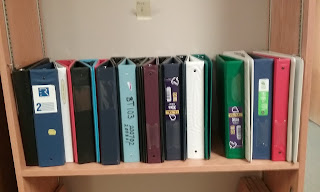While I admire those who can deliver brilliant lectures or lead class discussion without any written aids, I don't aspire to their example. The presence or absence of notes is, in my view, no sure sign of teaching effectiveness. Notes are not an instructor's training wheels to be abandoned when a teacher can ride without them. Nor need they be a constraint.
Depending on how many times I have taught the course, the notes become more of a prop than a constant reference, a security blanket, if you will, that gives me freedom to innovate and be present in class, focused on reaching and engaging my students without being distracted by the fear of losing my place or missing something crucial.
 My usual practice has been to print off a new set of notes before each class, and to mark them up lightly as part of my final class prep. If I have taught the course before, I glance at my marginal annotations from the previous iteration before finalizing the latest version.
My usual practice has been to print off a new set of notes before each class, and to mark them up lightly as part of my final class prep. If I have taught the course before, I glance at my marginal annotations from the previous iteration before finalizing the latest version.Inevitably, end-of-term haste means that the new binder of notes gets added to the old. Over time the paper adds up. As I cleaned my office this summer, the detritus of more than a decade's worth of teaching filled a recycle bin and led to a glut of empty binders.
The experience was motivation enough to look around for alternatives. If I had $700 USD to spare, I would be inclined to abandon paper altogether and switch over to Sony's newest Digital Paper solution, where "writing and drawing feel as natural as on real paper":
The only downside to the Sony DPT-RP1 is the price tag. Since money does not grow on trees, I expect to stick with real paper for the time being.


